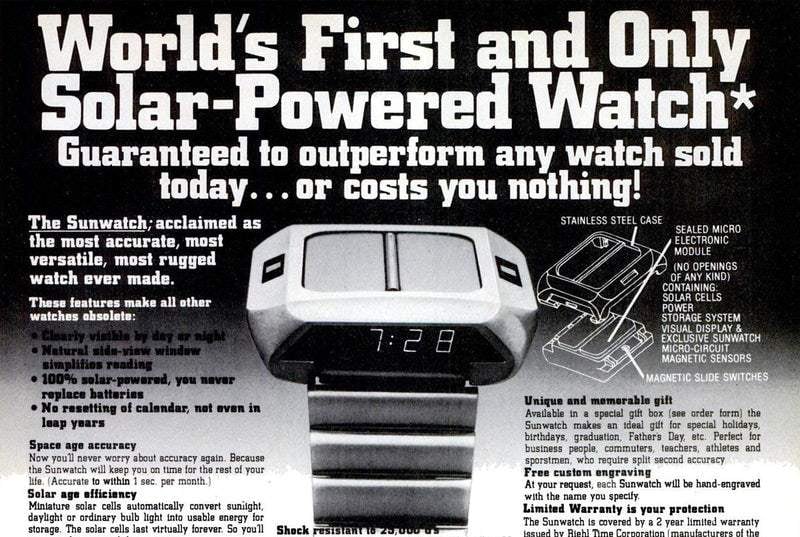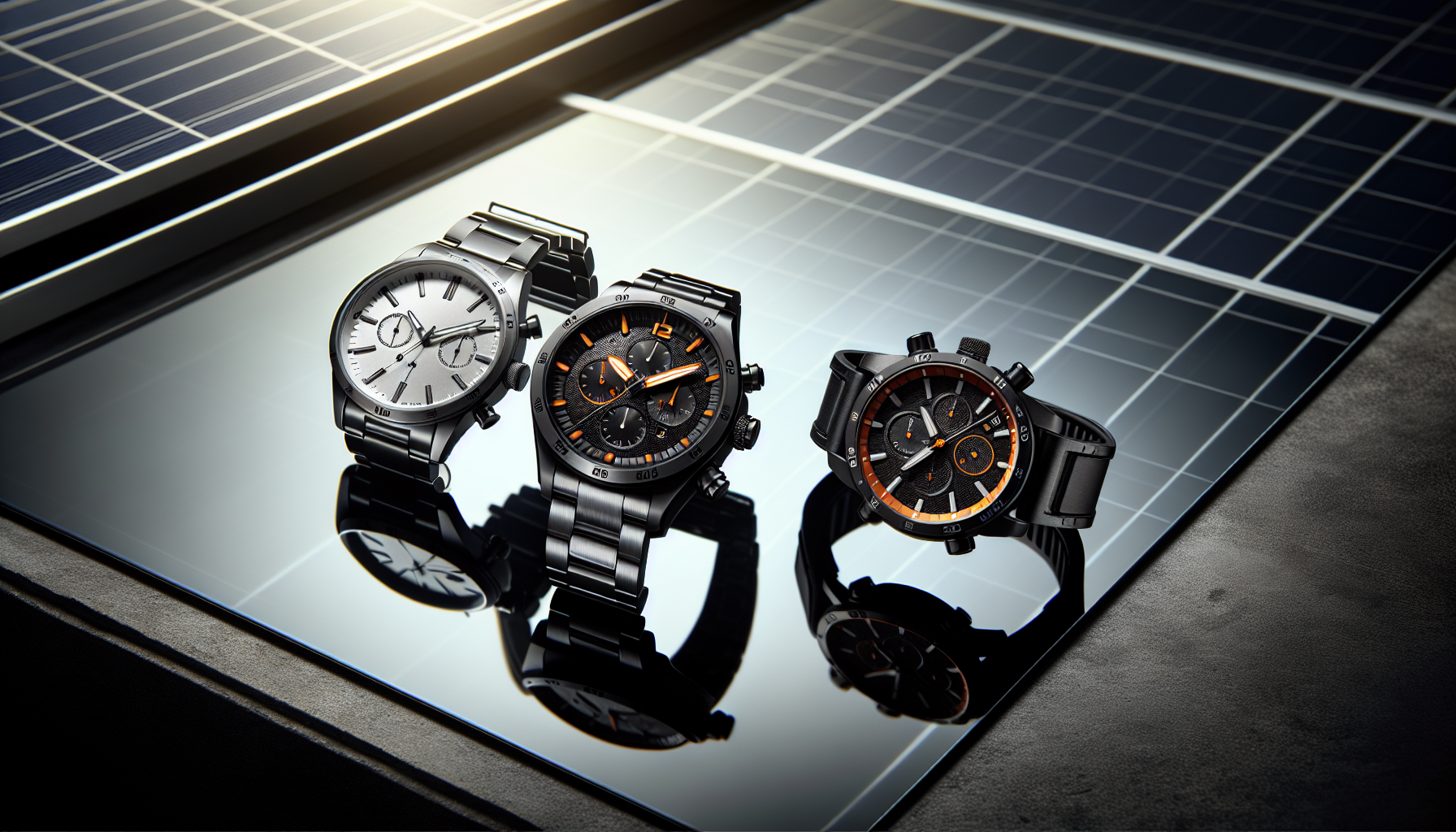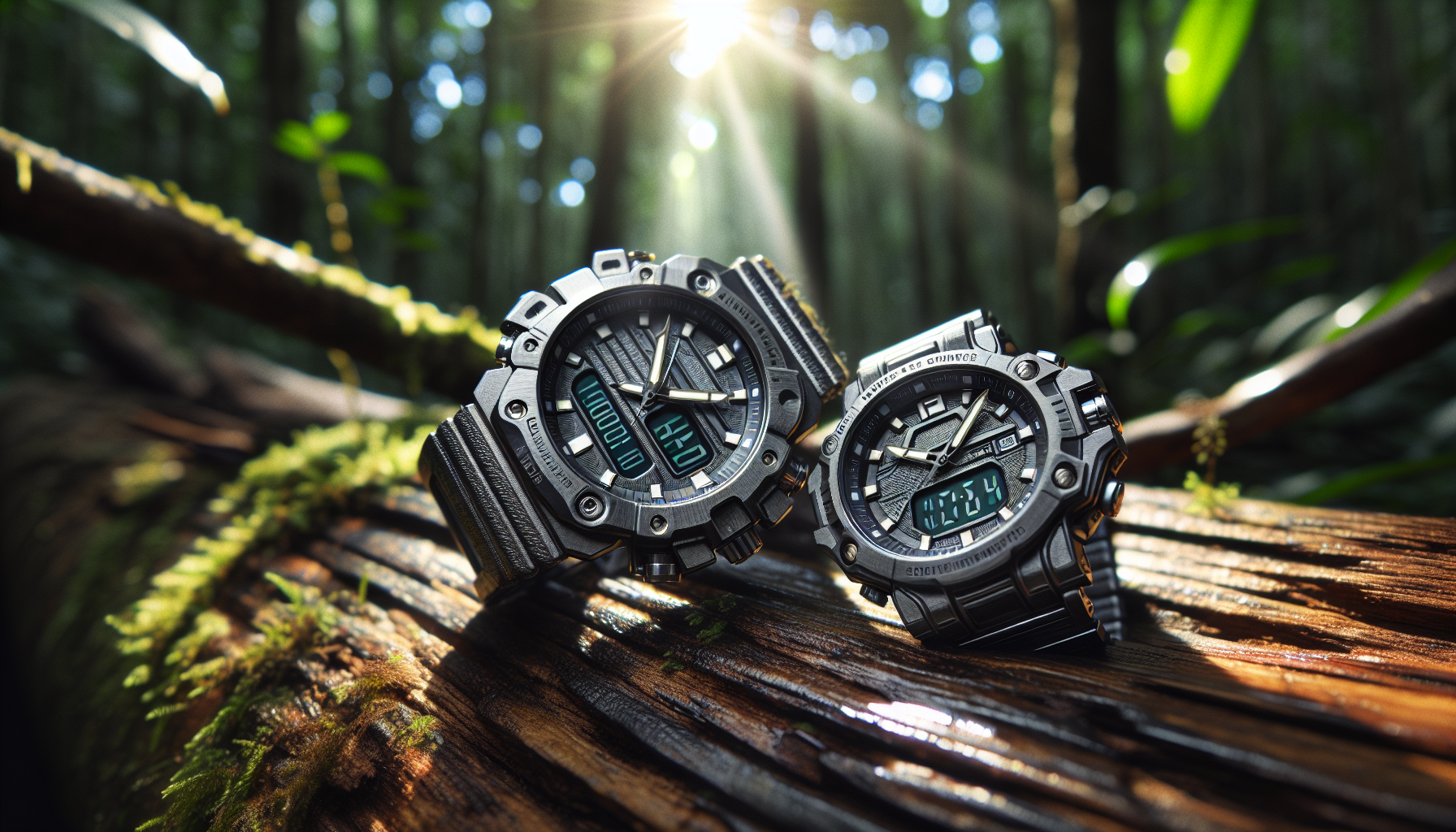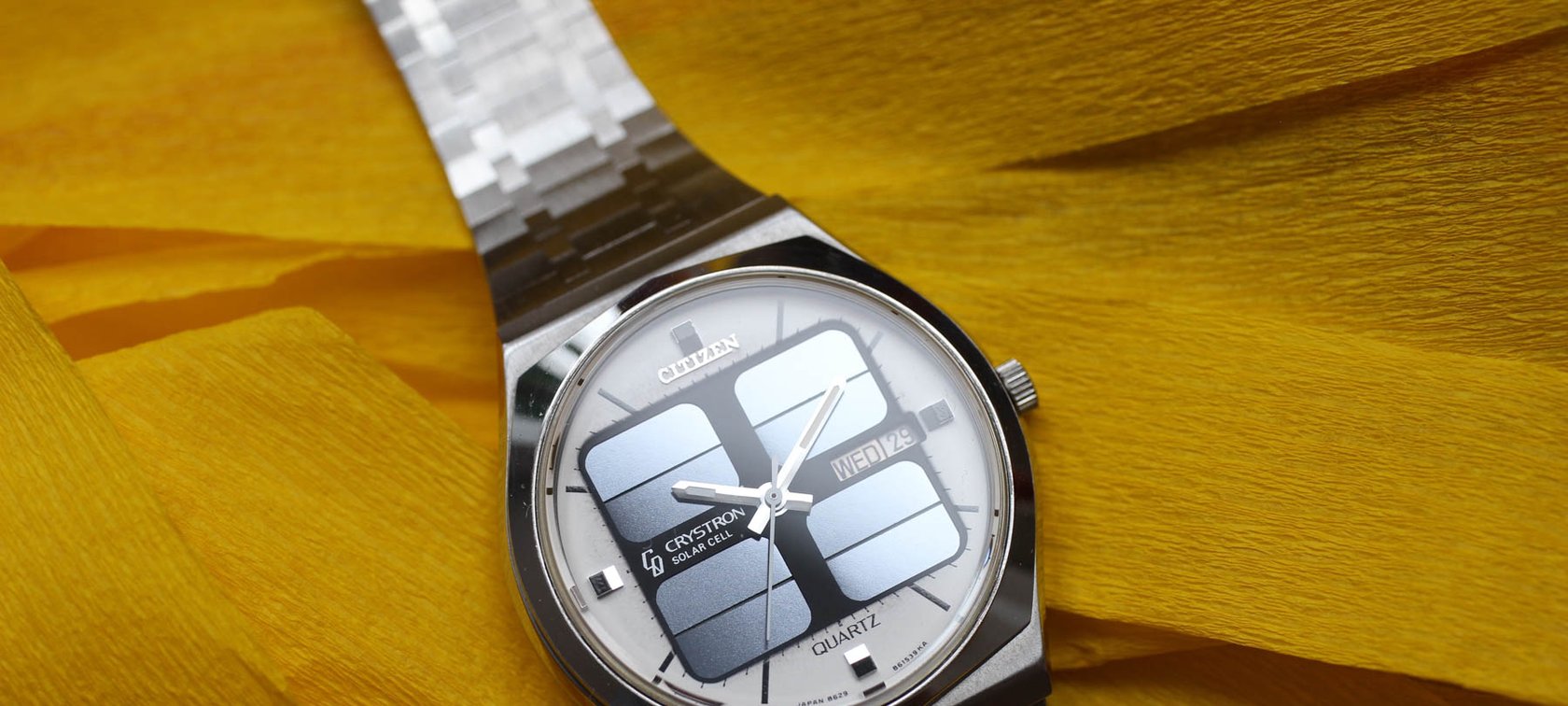As solar watches capture the spotlight in the timekeeping world, many are intrigued by their innovative use of technology and environmental benefits. These watches aren’t just accessories; they’re a testament to the advancement of wearable technology powered by light. This guide breaks down how solar watches work, their benefits, and guides you through a selection of notable models that are reshaping the industry.
The Evolution of Solar Watches
The journey of solar watches began with the conception of the ‘Synchronar’ in 1968 by Roger Riehl. With its unique ‘Space Age design’ and solar cells on top, it marked the birth of solar-powered watch technology, going into full production in 1972. The Synchronar had an impressive production run until 2007, making it one of the longest-running models in watch history.

The next significant milestone came in 1976 with the introduction of Citizen’s Crystron Solar Cell, the first analog solar watch. This marked a key technological advancement and laid the foundation for Citizen’s Eco-Drive series, entirely powered by light.

Japanese manufacturers like Citizen, Casio, and Seiko have played a significant role in the evolution of solar watches. Their collections, namely Eco-Drive, Tough Solar, and Seiko Solar, have made considerable strides in solar watch technology.
From the Synchronar to the advanced models of today, solar watches have come a long way. With cutting-edge technology, improved light absorption, and impressive power reserves, they have become an integral part of the horological world.
How Solar Watches Work: The Technology Behind Them
So how exactly do solar watches work? At the heart of every solar watch lies a solar cell, tucked neatly under the dial. This cell is responsible for transforming light energy into electronic energy. This energy then charges a special rechargeable battery that powers the watch, offering an efficient and sustainable energy solution.
Interestingly, solar watches can charge from any light source, not just sunlight. They can even charge under typical indoor lighting, making them incredibly versatile. A key design feature of solar watches is their semi-transparent dial. This allows light to pass through to the solar panel, ensuring efficient light capture and, in turn, enhancing the power of the watch.
One of the most impressive aspects of solar watches is their power reserves. Upon full charge, a solar watch can run for up to six months, even without exposure to light. However, they do require light exposure from time to time as they cannot charge in complete darkness.
Advantages of Choosing a Solar Watch
Solar watches offer a host of benefits, making them a worthy addition to any watch collection. One of the major draws of solar watch technology is its sustainability. By reducing the need for frequent battery changes, solar watches help minimize waste in landfills, making them an eco-friendly choice.
The cost-effectiveness of owning a solar watch is another significant advantage. Thanks to their long-lasting rechargeable batteries, the need for regular replacements is greatly diminished, saving you money in the long run.
Solar watches are also known for their impressive power reserves. They are capable of running for months without exposure to light, offering reliability and convenience that’s hard to beat.
Last but not least, solar watches come in a broad array of designs, including traditional quartz watches. Whether your style is classic or contemporary, sporty or sophisticated, there’s a solar watch to suit your taste. Plus, with the accuracy and reliability of solar powered quartz movement technology, solar watches represent a winning combination of style and performance, all thanks to the solar quartz movement.
Top Affordable Solar Watches for Everyday Wear

Solar watches aren’t just for the eco-conscious or the tech-savvy – they’re also a great choice for everyday wear. And with a wide range of affordable models on the market, owning a solar watch doesn’t have to break the bank.
Take the following solar watches into consideration:
- Citizen Promaster Diver Eco-Drive: This watch offers style and functionality in one package, making it an excellent everyday watch.
- Seiko Prospex Solar Dive Watch: A durable and reliable option for a solar watch.
- Casio G-SHOCK: Known for its durability, this model is a top contender for affordable solar watches in 2024.
The Bertucci DX3 Field offers a classic design with a lightweight polycarbonate case, while the Casio Edifice Sospensione combines sporty aesthetics with both digital and analog displays, all harnessing the power of the sun.
For those on a budget, the CASIO G-SHOCK GW6900-1 offers exceptional value at just $89 USD. The Citizen Promaster Diver, priced at $220 USD, is another affordable option that doesn’t compromise on features or style.
Many of these affordable solar watches also boast significant water resistance. The Seiko Prospex Solar Dive Watch and the Citizen Promaster Nighthawk, both rated to 200 meters, are perfect examples of this, making them suitable for diverse environments.
Luxury Solar Watches for the Discerning Collector

For those who appreciate the finer things in life, luxury brands like Cartier and TAG Heuer have embraced solar technology, offering high-end solar watches that combine style and sustainability.
The Cartier Tank Must SolarBeat, released in 2021, has become a modern classic. By integrating solar technology into one of the world’s most iconic watch collections, this watch offers a luxurious and eco-conscious choice, valued at $3,300.
TAG Heuer’s Aquaracer Professional 200 Solargraph, introduced in 2022, reflects the brand’s commitment to blending luxury with solar innovation.
- Solargraph movement, developed with La Joux-Perret
- Rapid charging capability with just two minutes of sunlight needed for a day’s charge
- Six-month power reserve when fully charged
Citizen, a pioneer in solar technology, has pushed the boundaries with their Citizen Eco Drive One series. Models like the one with Cermet bezels and proprietary Duratect coating showcase the brand’s commitment to durability. The series also includes a model with a 38mm one-piece case that’s only 3.88mm thick, marking significant achievements in lightweight and ultra-thin watchmaking.
The Seiko Selection Solar Chronograph Panda, on the other hand, impresses with a six-month power reserve on a full charge, showcasing the brand’s prowess in precision and energy efficiency.
Best Solar Watches for Outdoor Enthusiasts

For outdoor enthusiasts, solar watches offer the perfect blend of performance and durability. These watches are designed to withstand tough conditions, making them an ideal choice for adventurers and athletes alike. Some great examples of solar watches are:
- Garmin quatix 7X
- Garmin fenix 6 Pro Solar
- Garmin Instinct Solar
- Garmin fēnix 6 Pro Solar
These stainless steel watches with blue dial offer rugged designs, suitable for boating, multisport, and military-grade requirements, all housed in a stainless steel case.
In addition to their robust build, these watches boast significant features:
- Battery life bolstered by solar charging
- The quatix 7X Solar Edition can last up to 139 days on a single charge
- The Garmin Instinct 2 Solar’s battery life is virtually unlimited with solar exposure.
Models like the Casio G-Shock Move, Garmin quatix 7X, and Instinct Solar also come packed with features tailored for specific outdoor pursuits such as running, boating, and hiking. These features include GPS navigation, waypoint marking, heart rate monitoring, and tide changes, making these watches more than just timepieces.
For advanced athletes and fitness enthusiasts, some models offer features such as VO2 max estimation, recovery time suggestions, and training load balance. The Garmin fenix 6 Pro Solar and Forerunner 955 Solar are perfect examples of this, offering a suite of advanced fitness features.
Solar Watches with Unique Features and Functions
In recent years, solar watch technology has expanded to include a host of unique features and functions, offering users added convenience and functionality.
One such advancement is the integration of smartwatch functions, such as connectivity and health monitoring. The Tissot T-Touch Connect Solar, for example, combines solar and smartwatch technologies, offering enhanced user interaction.
G-Shock’s GAB-2100 ‘CasiOak’ is another example, integrating Tough Solar technology with Bluetooth and various smartwatch features such as a world-time function and calendar.
Advanced features like GPS and atomic timekeeping have also been integrated into solar powered timepieces, including solar powered watches, thanks to their reliable and sustainable energy source. The Seiko Astron GPS Solar SSH109, for instance, not only harnesses solar power but also offers GPS signal reception, world time functions, and a perpetual calendar.
Another noteworthy model is the Junghans Max Bill MEGA Solar Titanium, which combines solar power with radio-controlled time via the Junghans MEGA app, ensuring precision timekeeping.
Tips for Maintaining and Caring for Your Solar Watch
Like any timepiece, a solar watch requires proper care and maintenance to ensure its longevity. Here are some tips to help you keep your solar watch in top condition.
Regular servicing or an overhaul every 3 to 4 years is recommended to check for mechanical wear, maintain oil lubrication, and ensure waterproof seals are intact. To maintain recharging efficiency and prevent damage, avoid charging solar watches on a car dashboard due to high heat levels. Regularly clean the watch face to ensure maximum light absorption.
When repairs or band replacement is required, seek professional service that specializes in solar watches. This is crucial in maintaining the water resistance of solar watches, as the seals should be checked and replaced by a professional every couple of years. Lastly, keep solar watches away from strong magnetic fields to prevent any potential impact on their timekeeping accuracy.
Solar Watch Trends and Future Developments
As we look towards the future, solar watch technology continues to evolve. From advancements in materials to the integration of AI and IoT, the solar watch market is poised for exciting developments.
New materials like perovskite solar cells, as well as advancements in power management and energy storage technologies such as solid-state batteries and supercapacitors, are enhancing the efficiency of solar-powered wearable technology by optimizing the conversion of electrical energy.
Design is also a key focus, with future solar wearables expected to offer slimmer, more fashion-forward appearances.
The integration of AI and IoT is also on the horizon, promising multifunctional capabilities, optimized power usage, and additional features such as health monitoring and augmented reality.
The solar watch market, driven by the solar movement, is trending towards:
- A more sustainable and convenient user experience
- The introduction of solar technology in luxury watch segments
- A focus on consumer education on the benefits of solar wearables.
Iconic Solar Watch Models and Their Impact on the Industry
Solar watches have come a long way since their inception, and along the way, some models have left an indelible mark on the industry. The Hamilton Watch company pioneered solar watch technology in the mid-1950s with the Ventura model, setting the stage for future developments. Citizen’s Eco-Drive technology, introduced in 1976, has been a major influence in the watchmaking industry and continues to be a leading technology in the market.
The Seiko Ana-Digi Tuna SNJ025, nicknamed the ‘Arnie’, became popular after being worn by Arnold Schwarzenegger and features a 6-month power reserve. The G-Shock GW6900-1, introduced in 1983, revolutionized the industry with its radio-controlled, atomic timekeeping technology.
Summary
Solar watches offer a compelling fusion of technology and style, marrying sustainability with functionality. From their evolution to the workings of their technology, their benefits, and their diverse range – there’s a solar watch to suit every taste and budget. As we look to the future, advancements in materials, power management, and the integration of AI and IoT promise to take solar watches to new heights. So, whether you’re an outdoor enthusiast, a discerning collector, or simply someone seeking a stylish and sustainable timepiece, a solar watch could be the perfect choice for you.
Frequently Asked Questions
How do solar watches work?
Solar watches work by converting light energy into electronic energy using a solar cell under the dial, which is then stored in a rechargeable battery to power the watch. This process allows the watch to function without the need for regular battery replacements.
Which is better quartz or solar watch?
A solar watch is better than a quartz watch because its rechargeable battery can last up to 10 years, compared to the 1 to 3 year lifespan of a quartz watch battery. This makes solar watches an advancement in horology technology.
Why do solar watches stop working?
Solar watches stop working when they cannot be exposed to light for a long time, such as when they are concealed under a sleeve or used/stored in conditions without light.
How long will a solar watch last?
A solar watch can last between 7 to 20 years, depending on the brand and frequency of recharging. With proper maintenance, solar-powered watches are highly reliable for accurate timekeeping.
What are the benefits of a solar watch?
Solar watches offer sustainability, cost-effectiveness, impressive power reserves, and diverse designs, making them a practical choice for consumers.

